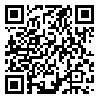Volume 20, Issue 1 (4-2024)
J Health Syst Res 2024, 20(1): 10-16 |
Back to browse issues page
Research code: 399924
Ethics code: IR.MUI.RESEARCH.REC.1399.752
Download citation:
BibTeX | RIS | EndNote | Medlars | ProCite | Reference Manager | RefWorks
Send citation to:



BibTeX | RIS | EndNote | Medlars | ProCite | Reference Manager | RefWorks
Send citation to:
Niknadaf F, Karimi-Zeverdegani S. Examining the Relationship between Safety Climate and Mental Workload with Stress, Anxiety and Depression in ABFA Personnel of Isfahan Province, Iran. J Health Syst Res 2024; 20 (1) :10-16
URL: http://hsr.mui.ac.ir/article-1-1445-en.html
URL: http://hsr.mui.ac.ir/article-1-1445-en.html
1- MSc Student, Student Research Committee AND Department of Occupational Health and Safety Engineering, School of Health, Isfahan University of Medical Sciences, Isfahan, Iran
2- Associate Professor, Department of Occupational Health and Safety Engineering, School of Health, Isfahan University of Medical Sciences, Isfahan, Iran
2- Associate Professor, Department of Occupational Health and Safety Engineering, School of Health, Isfahan University of Medical Sciences, Isfahan, Iran
Abstract: (2510 Views)
Background: The relationship of safety climate and mental workload with stress, anxiety, and depression is one of the performance indicators of occupational health and safety management in the workplace, which evaluates the attitude of employees towards safety issues. The purpose of this study is to investigate the relationship between safety climate and mental workload with stress, anxiety, and depression in ABFA Company personnel in Isfahan Province, Iran.
Methods: This is a descriptive-analytical and cross-sectional study. The statistical population included 254 employees of the water and sewage incidents team in six regions of Isfahan City and the water and sewage crisis team and the relevant supervisors. The data collection tools in this research were the standard Depression, Stress, and Anxiety Scale (DASS-21), the standard NASA Task Load Index (NASA-TLX), and the standard Nordic Occupational Safety Climate Questionnaire (NOSACQ).
Findings: The increase in depression, anxiety, and stress was associated with the increase in mental workload in the target group (P < 0.05). Besides, the calculated beta coefficients were negative, which indicates an increase in depression, anxiety, and stress with a decrease in safety atmosphere in the target group personnel (P < 0.05)
Conclusion: The crisis team has a significant mental load in today's work environment because the tasks they perform require extreme caution and attention and must be free of any mistakes. Therefore, efforts should be made to reduce their mental load so that they can perform better. Increased depression may significantly affect people's physical and mental health and reduce their performance, commitment, quality of life, and satisfaction. Hence, the components of mental loads should be controlled and relevant measures should be taken to reduce the workload.
Methods: This is a descriptive-analytical and cross-sectional study. The statistical population included 254 employees of the water and sewage incidents team in six regions of Isfahan City and the water and sewage crisis team and the relevant supervisors. The data collection tools in this research were the standard Depression, Stress, and Anxiety Scale (DASS-21), the standard NASA Task Load Index (NASA-TLX), and the standard Nordic Occupational Safety Climate Questionnaire (NOSACQ).
Findings: The increase in depression, anxiety, and stress was associated with the increase in mental workload in the target group (P < 0.05). Besides, the calculated beta coefficients were negative, which indicates an increase in depression, anxiety, and stress with a decrease in safety atmosphere in the target group personnel (P < 0.05)
Conclusion: The crisis team has a significant mental load in today's work environment because the tasks they perform require extreme caution and attention and must be free of any mistakes. Therefore, efforts should be made to reduce their mental load so that they can perform better. Increased depression may significantly affect people's physical and mental health and reduce their performance, commitment, quality of life, and satisfaction. Hence, the components of mental loads should be controlled and relevant measures should be taken to reduce the workload.
Type of Study: Research |
Subject:
Occupational health engineering and occupational safety
Received: 2022/08/27 | Accepted: 2023/05/20 | Published: 2024/04/3
Received: 2022/08/27 | Accepted: 2023/05/20 | Published: 2024/04/3
Send email to the article author
| Rights and permissions | |
 |
This work is licensed under a Creative Commons Attribution-NonCommercial 4.0 International License. |







